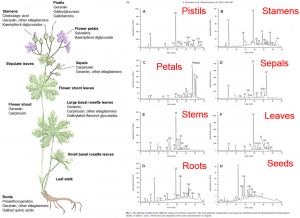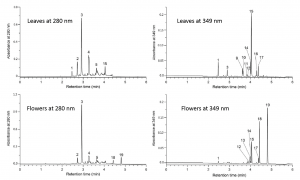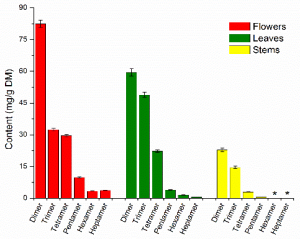If different plant parts have variable external stress factors such as herbivory, it may be expected to find variable defense chemistries between the tissue types, but the differences do not need to be huge
Foliar chemistry is the most important thing – but there is more

Figure 1. The organ-specific variation of polyphenols in Geranium sylvaticum. For details, please see Tuominen et al. (2013), Tuominen (2013), Tuominen et al. (2015) and Tuominen & Salminen (2017).
It is quite an adventure for a phytochemist to reveal the differences in the foliar chemistry of hundreds of plant species. So it may either come as an injection of frustration or excitement to hear that it also necessary to check the chemical differences between plant parts of each species. Luckily this of course depends on the questions the phytochemist is trying to answer :).
According to our knowledge and data at the Natural Chemistry Research Group, many plant species do have quite variable defense chemistry between their tissue types, but on the other hand some species have almost the same chemistry in leaves, flowers, seeds and stem. In the latter case roots tend to be different.
Geranium sylvaticum – the queen of phytochemical variation
Our most spectacular example of tissue-specific phytochemical variation most certainly is related to Geranium sylvaticum. It clearly has one of the most complex polyphenol and tannin chemistries shared between its organs. The species as such is known for its ability to produce the DHHDP-type ellagitannins such as geraniin. This compound is the major compound in leaves and can be found also in other organs, but it is not found in petals that we found to be able to produce new types of hydrolysable tannins, i.e. sylvatiins (Fig. 1).
The world’s largest ellagitannins show only modest variation

Figure 3. UPLC-DAD chromatograms of the polyphenol extracts of Epilobium angustifolium leaves and flowers at 280 nm (showing all polyphenols) and at 349 nm (showing mainly flavonol glycosides). It can be clearly seen that main qualitative differences between the tissue types come from the flavonoids. For details, please see Baert et al. (2017).

Figure 2. Flowers, leaves and stems of Epilobium angustifolium contain the same oligomeric ellagitannins. Flowers have highest total level of ellagitannins, but the lowest ratio of the trimer to the dimer. For details, please see Baert et al. (2017).
The organs of Epilobium angustifolium contain the largest ellagitannins in the plant kingdom, but they do not show much variation between the willowherb organs (Fig. 2) The only significant difference comes from the between tissue concentrations and from the proportions of trimer to dimer that is that is much higher in leaves and stem than in flowers. The main qualitative differences come instead from the flavonoid composition as shown in Fig. 3.
“Do not unite what Mother Nature has separated!”
